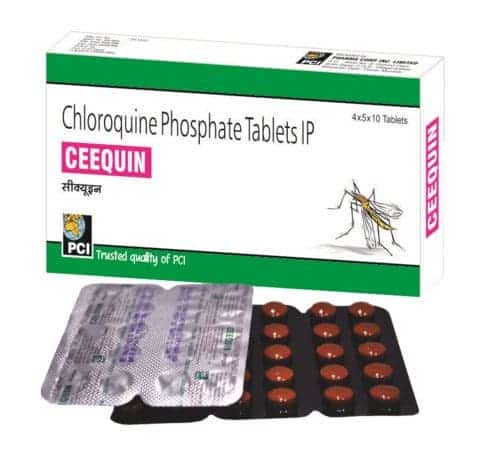
A few weeks ago, preliminary studies suggested that an anti-malaria drug called chloroquine might improve the outcomes of patients sick with COVID-19. However, most of these studies are very limited or even use flawed methodologies. Given the urgency of the matter, regulators and doctors have been forced to take shortcuts they would have not otherwise taken, recommending the use of the drug in some cases. Now, there are quite a few reports of disturbing side effects.
Cramps and loss of peripheral vision, among common side effects of the anti-malaria drugs whose use against COVID-19 has been touted.
Several hospitals in Sweden have now reportedly stopped administering chloroquine to COVID-19 patients, many doctors claiming that they aren’t confident it works to relieve symptoms — not enough to merit the side effects, which include cramps and loss of peripheral vision.
Speaking to the Gothenburg Post, Magnus Gisslén, a professor and chief physician at Sahlgrenska University Hospital infection clinic, said he and colleagues have been prescribing the drug for the last two weeks — typically two daily tablets — until they were recently ordered to stop all use of chloroquine for COVID-19 treatment.
“There were reports of suspected more serious side effects than we first thought,” Gisslén told Swedish reporters last week. “We cannot rule out serious side effects, especially from the heart, and it is a hard-dosed drug. In addition, we have no strong evidence that chloroquine has an effect on COVID-19.”
The anti-malaria drugs chloroquine and hydroxychloroquine came to everyone’s attention after President Donald Trump praised their use as a potential treatment for COVID-19, calling them a ‘game-changer’. The US Food and Drug Administration (FDA) also approved the use of the drugs against COVID-19 last week while the federal government stockpiled 29 million pills of hydroxychloroquine.
Besides the US, France has also authorized doctors to prescribe anti-malaria drugs for patients with COVID-19. India’s health ministry has recommended the use of hydroxychloroquine as a preventative treatment for healthcare workers. Other countries that have authorized its use include Bahrain, Morocco, Algeria, and Tunisia.
In contrast, the European Medicines Agency restricted the general use of the drugs to patients taking them for approved indications.
Not long after the initial wave of enthusiastic reports in the mainstream news of chloriquine’s potential therapeutic properties against COVID-19, an Arizona man died, and his wife was hospitalized, after ingesting a fish-tank cleaner made from chloroquine phosphate — which is not the same thing at all the substance found in the drugs. However, there have been deaths reported in Nigeria among people self-treating for apparent COVID-19, which were attributed to chloroquine overdoses
The World Health Organization (WHO) clearly states there is no definitive evidence they work against COVID-19. So, where did everyone get the idea to use these drugs in the first place?
Chloroquine was discovered in 1934 by Hans Andersag but was initially ignored for a decade because it was considered too toxic for human use. Since then, the drug has made it onto the World Health Organization’s List of Essential Medicines, which contains the safest and most effective medicines for various diseases.
Several studies have touted their efficacy against COVID-19. The first such evidence came from clinical trials in over 10 hospitals in Beijing, as well as in south China’s Guangdong Province and central China’s Hunan Province, which showed fairly good efficacy.
However, other scientists have reported mixed results. A recent study published in the Journal of Zhejiang University found that hydroxychloroquine showed no statistically relevant benefits when compared to standard care in 30 patients diagnosed with COVID-19.
Much excitement about the role of chloroquine in treating COVID-19 was the result of a French clinical study involving just around 80 patients. However, the study was soon criticized for its poor design by experts. For instance, most of the patients only had mild symptoms, 85% of them missing fever, which is usually a major telltale symptom of the virus.
Darren Dahly, a principal statistician at the University College Cork School of Public Health, expressed deep concerns, saying it would be “egregious” to recommend treatments for millions of people based on such small trials — that’s regardless of how well the trials have been designed. Dr. Anthony Fauci said “the data are really just at best suggestive”, referring to the potential benefits of hydroxychloroquine in treating COVID-19.
The latest study that dismisses the role of hydroxychloroquine was published last week by a different group of French researchers, finding no evidence that the drug helps the immune system clear the coronavirus from the body.
Ongoing randomized clinical trials with hydroxychloroquine should provide a definitive answer regarding the alleged efficacy of this combination and will assess its safety. Until that happens, the use of these drugs should be extremely limited and only under medical supervision. This means no self-medication whatsoever!
Doctors say that hydroxychloroquine is relatively safe, a fact that is attested by decades of use in treating not just malaria, but also lupus or rheumatoid arthritis. However, this is a prescription drug that is toxic, meaning that people who self-medicate risk of developing severe complications or even dying. Previously reported severe side effects include life-threatening cardiac damage and suicidal behavior.






